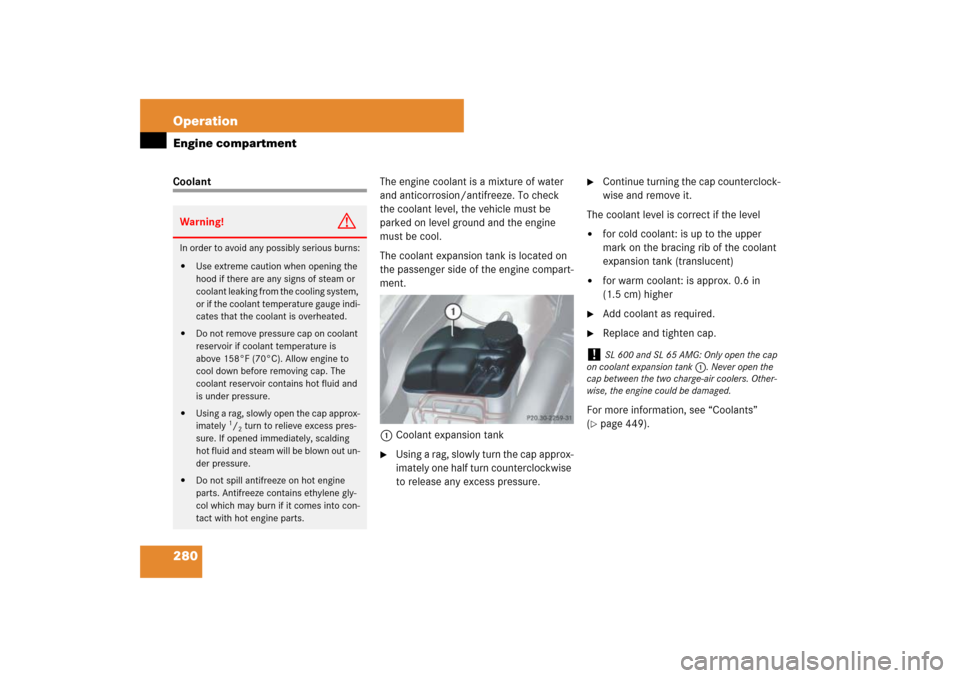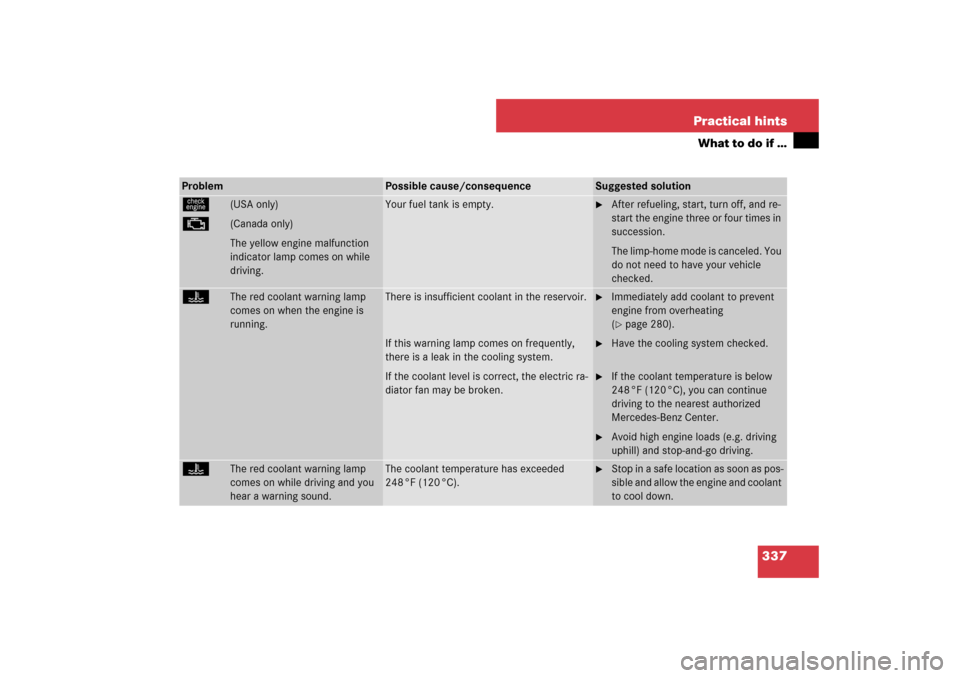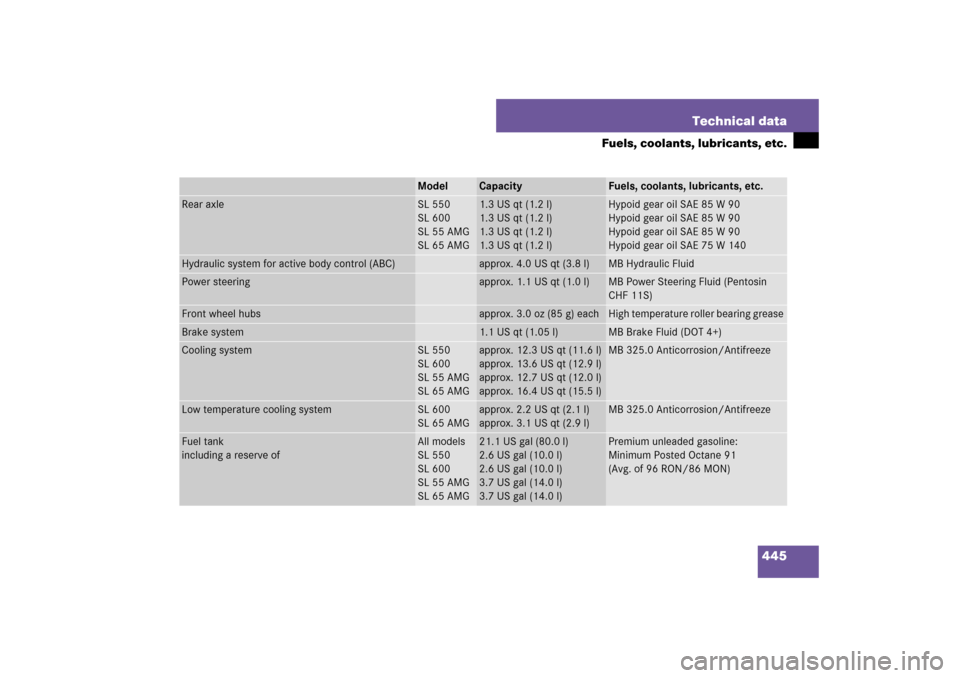Page 196 of 473
195 Controls in detail
Automatic climate control
Deactivating�
Press button T (
�page 185).
The indicator lamp on the button goes
out.
The residual heat is automatically turned
off:
�
when the ignition is switched on
�
after about 30 minutes
�
if the battery voltage drops
Ventilated glove box
The glove box has its own air vents that al-
low for cooling ventilation when the auto-
matic climate control system is activated.Glove box1Thumbwheel
2Air ventOpening the air vent
�
Make sure the air vent in the glove box
is unobstructed.
�
Turn thumbwheel1 upwards.
Closing the air vent
�
Turn thumbwheel1 downwards.
i
You should keep air vent 2 closed when
outside temperatures are low.
Page 281 of 473

280 OperationEngine compartmentCoolantThe engine coolant is a mixture of water
and anticorrosion/antifreeze. To check
the coolant level, the vehicle must be
parked on level ground and the engine
must be cool.
The coolant expansion tank is located on
the passenger side of the engine compart-
ment.
1Coolant expansion tank
�
Using a rag, slowly turn the cap approx-
imately one half turn counterclockwise
to release any excess pressure.
�
Continue turning the cap counterclock-
wise and remove it.
The coolant level is correct if the level
�
for cold coolant: is up to the upper
mark on the bracing rib of the coolant
expansion tank (translucent)
�
for warm coolant: is approx. 0.6 in
(1.5 cm) higher
�
Add coolant as required.
�
Replace and tighten cap.
For more information, see “Coolants”
(
�page 449).
Warning!
G
In order to avoid any possibly serious burns:�
Use extreme caution when opening the
hood if there are any signs of steam or
coolant leaking from the cooling system,
or if the coolant temperature gauge indi-
cates that the coolant is overheated.
�
Do not remove pressure cap on coolant
reservoir if coolant temperature is
above 158°F (70°C). Allow engine to
cool down before removing cap. The
coolant reservoir contains hot fluid and
is under pressure.
�
Using a rag, slowly open the cap approx-
imately
1/2 turn to relieve excess pres-
sure. If opened immediately, scalding
hot fluid and steam will be blown out un-
der pressure.
�
Do not spill antifreeze on hot engine
parts. Antifreeze contains ethylene gly-
col which may burn if it comes into con-
tact with hot engine parts.
!
SL 600 and SL 65 AMG: Only open the cap
on coolant expansion tank1. Never open the
cap between the two charge-air coolers. Other-
wise, the engine could be damaged.
Page 338 of 473

337 Practical hints
What to do if …
Problem
Possible cause/consequence
Suggested solution
ú
(USA only)
±
(Canada only)
The yellow engine malfunction
indicator lamp comes on while
driving.
Your fuel tank is empty.
�
After refueling, start, turn off, and re-
start the engine three or four times in
succession.
The limp-home mode is canceled. You
do not need to have your vehicle
checked.
D
The red coolant warning lamp
comes on when the engine is
running.
There is insufficient coolant in the reservoir.
If this warning lamp comes on frequently,
there is a leak in the cooling system.
If the coolant level is correct, the electric ra-
diator fan may be broken.
�
Immediately add coolant to prevent
engine from overheating
(�page 280).
�
Have the cooling system checked.
�
If the coolant temperature is below
248 °F (120 °C), you can continue
driving to the nearest authorized
Mercedes-Benz Center.
�
Avoid high engine loads (e.g. driving
uphill) and stop-and-go driving.
D
The red coolant warning lamp
comes on while driving and you
hear a warning sound.
The coolant temperature has exceeded
248 °F (120 °C).
�
Stop in a safe location as soon as pos-
sible and allow the engine and coolant
to cool down.
Page 374 of 473

373 Practical hints
What to do if …
Left display
Right display
Possible cause/consequence
Possible solution
B
Top up
coolant
See Oper. Manual
The coolant level is too low.
�
Add coolant (
�page 280).
Comply with all warnings while doing so.
�
If you have to add coolant frequently, have the
cooling system checked by an authorized
Mercedes-Benz Center.
•
The cooling fan for the coolant is
malfunctioning.
�
Observe the coolant temperature gauge in the
instrument cluster (
�page 27).
If the coolant temperature is under 120°C,
you may continue driving to the nearest spe-
cialist workshop.
�
Avoid placing heavy loads on the engine
(e.g. by driving uphill) as well as stop-and-go
traffic.
�
Have the fan replaced as soon as possible.
Warning!
G
Do not spill antifreeze on hot engine parts.
Antifreeze contains ethylene glycol which
may burn if it comes into contact with hot
engine parts. You can be seriously burned.
!
Do not ignore the low engine coolant level
warning. Extended driving with this message and
symbol displayed may cause serious engine
damage not covered by the
Mercedes-Benz Limited Warranty. Do not drive
without sufficient amount of coolant in the cool-
ing system. The engine will overheat, causing
major engine damage.
Page 446 of 473

445 Technical data
Fuels, coolants, lubricants, etc.
Model
Capacity
Fuels, coolants, lubricants, etc.
Rear axle
SL 550
SL 600
SL 55 AMG
SL 65 AMG
1.3 US qt (1.2 l)
1.3 US qt (1.2 l)
1.3 US qt (1.2 l)
1.3 US qt (1.2 l)
Hypoid gear oil SAE 85 W 90
Hypoid gear oil SAE 85 W 90
Hypoid gear oil SAE 85 W 90
Hypoid gear oil SAE 75 W 140
Hydraulic system for active body control (ABC)
approx. 4.0 US qt (3.8 l)
MB Hydraulic Fluid
Power steering
approx. 1.1 US qt (1.0 l)
MB Power Steering Fluid (Pentosin
CHF 11S)
Front wheel hubs
approx. 3.0 oz (85 g) each
High temperature roller bearing grease
Brake system
1.1 US qt (1.05 l)
MB Brake Fluid (DOT 4+)
Cooling system
SL 550
SL 600
SL 55 AMG
SL 65 AMG
approx. 12.3 US qt (11.6 l)
approx. 13.6 US qt (12.9 l)
approx. 12.7 US qt (12.0 l)
approx. 16.4 US qt (15.5 l)
MB 325.0 Anticorrosion/Antifreeze
Low temperature cooling system
SL 600
SL 65 AMG
approx. 2.2 US qt (2.1 l)
approx. 3.1 US qt (2.9 l)
MB 325.0 Anticorrosion/Antifreeze
Fuel tank
including a reserve of
All models
SL 550
SL 600
SL 55 AMG
SL 65 AMG
21.1 US gal (80.0 l)
2.6 US gal (10.0 l)
2.6 US gal (10.0 l)
3.7 US gal (14.0 l)
3.7 US gal (14.0 l)
Premium unleaded gasoline:
Minimum Posted Octane 91
(Avg. of 96 RON/86 MON)
Page 450 of 473

449 Technical data
Fuels, coolants, lubricants, etc.
In areas where carbon deposits may be en-
countered due to lack of availability of gas-
olines which contain these additives,
Mercedes-Benz recommends the use of
additives approved by us for use on
Mercedes-Benz vehicles. Refer to Factory
Approved Service Products pamphlet for a
listing of approved product(s). Follow di-
rections on product label.
Do not blend other fuel additives with fuel.
This only results in unnecessary cost and
may be harmful to the engine operation.
Damage or malfunction resulting from
poor fuel quality or from blending addition-
al fuel additives other than those tested
and approved by us for use on
Mercedes-Benz vehicles listed in the
Factory Approved Service Products pam-
phlet are not covered by the
Mercedes-Benz Limited Warranty.
Coolants
The engine coolant is a mixture of water
and anticorrosion/antifreeze, which pro-
vides:�
corrosion protection
�
freeze protection
�
boiling protection (by increasing the
boiling point)
The cooling system was filled at the factory
with a coolant providing freeze protection
to approximately -22°F (-30°C) and corro-
sion protection.If the antifreeze mixture is effective to
-22°F (-30°C), the boiling point of the cool-
ant in the pressurized cooling system is
reached at approximately 266°F (130°C).
The coolant solution must be used year
round to provide the necessary corrosion
protection and increase in the boil-over
protection. Refer to Maintenance Booklet
for replacement interval.
Coolant system design and coolant used
stipulate the replacement interval. The re-
placement interval published in the
Maintenance Booklet is only applicable if
MB 325.0 anticorrosion/antifreeze solu-
tion or other Mercedes-Benz approved
products of equal specification (see
Factory Approved Service Products pam-
phlet) are used to renew the coolant con-
centration or bring it back up to the proper
level.
!
Add premixed coolant solution only. Adding
water and MB 325.0 Anticorrosion/Antifreeze
separately from each other, could cause engine
damage not covered by the Mercedes-Benz
Limited Warranty.
Page 451 of 473
450 Technical dataFuels, coolants, lubricants, etc.To provide important corrosion protection,
the solution must be at least 45% anticor-
rosion/antifreeze (equivalent to freeze
protection to approx. - 22°F [-30°C]). If
you use a solution that is more than 55%
anticorrosion/antifreeze (freeze protec-
tion to approx. - 49°F [-45°C]), the engine
temperature will increase due to the lower
heat transfer capability of the solution.
Therefore, do not use more than this
amount of anticorrosion/antifreeze.If the coolant level is low, water and
MB 325.0 Anticorrosion/Antifreeze
should be used to bring it up to the proper
level (have cooling system checked for
signs of leakage). Please make sure the
mixture is in accordance with label instruc-
tions.
The water in the cooling system must meet
minimum requirements, which are usually
satisfied by normal drinking water. If you
are not sure about the water quality, con-
sult an authorized Mercedes-Benz Center.
Page 452 of 473

451 Technical data
Fuels, coolants, lubricants, etc.
Anticorrosion/antifreeze
Your vehicle contains a number of alumi-
num parts. The use of aluminum compo-
nents in motor vehicle engines
necessitates that anticorrosion/antifreeze
coolant used in such engines be specifical-
ly formulated to protect the aluminum parts. (Failure to use such anticorro-
sion/antifreeze coolant will result in a sig-
nificantly shortened service life.)
Therefore, the following product is strongly
recommended for use in your vehicle:
Mercedes-Benz 325.0 anticorrosion/anti-
freeze agent.Before the start of the winter season (or
once a year in hot southern regions), you
should have the anticorrosion/antifreeze
concentration checked. The coolant is also
regularly checked each time you bring your
vehicle to an authorized Mercedes-Benz
Center for service.
Anticorrosion/antifreeze quantityModel
Approx. freeze protection
– 35°F (– 37°C)
– 49°F (– 45°C)
SL 550
6.1 US qt (5.8 l)
6.8 US qt (6.4 l)
SL 600 (main cooling system)
6.9 US qt (6.5 l)
7.5 US qt (7.1 l)
SL 600 (low temperature cooling system)
1.2 US qt (1.1 l)
1.3 US qt (1.2 l)
SL 55 AMG
6.3 US qt (6.0 l)
7.0 US qt (6.6 l)
SL 65 AMG (main cooling system)
8.2 US qt (7.75 l)
9.0 US qt (8.5 l)
SL 65 AMG (low temperature cooling system)
1.5 US qt (1.45 l)
1.7 US qt (1.6 l)